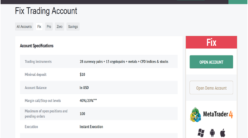Trading currencies in the foreign exchange market can be lucrative and rewarding. However, before beginning currency trading, it is essential to understand certain concepts such as Forex spreads. Forex spreads, also known as the difference between the bid and ask prices of a currency pair, play an important role in forex trading.

To help traders have an efficient and profitable experience when working in this highly volatile market, this article will provide you with valuable information on how to calculate forex spreads so that you can make sound investments. From looking at different currency pairs to understanding points vs pips, all the critical knowledge needed for correctly estimating your spread cost will be discussed here today.
What is a Forex spread?
Forex spread is a fundamental concept in foreign exchange trading. It refers to the difference between the bid price and the ask price of a currency pair. The bid price is the highest price a buyer is willing to pay for a currency, while the ask price is the lowest price at which a seller is willing to sell a currency. The difference between these two prices is measured in pips and represents the broker’s profit.
Essentially, the Forex spread is the cost of doing business when trading currencies. It is a crucial variable in Forex trading and can significantly affect the profitability of trades. A trader needs to understand the spread dynamics to make informed decisions about when to enter or exit a trade. It is essential in Forex trading to keep an eye on the spread and select a broker with the best spread. At Saxo, they offer some of the tightest spreads in the industry to help their clients potentially maximise their profits.
How to calculate the base currency and quote currency
When trading Forex, you frequently encounter terms such as base and quote currency. The base currency is the first currency in a currency pair, while the quote currency is the second. To calculate forex spreads, you must understand how to calculate these two currencies. For example, consider the EUR/USD pair with an exchange rate of 1.2000. In this case, the EUR is the base currency, and USD is the quote currency. It means that one euro can purchase 1.2000 US dollars.
When quoting a price for a currency pair, the first currency listed will always be the base currency, while the second one will always be the quote currency. Understanding this convention is crucial in calculating Forex spreads accurately.
The different types of spreads and which are best for specific trading strategies
There are two main types of spreads in Forex trading: fixed and variable. A fixed spread remains constant regardless of market conditions, while a variable spread can fluctuate depending on market volatility. Each type has its advantages and disadvantages, so it is essential to understand which one works best for your trading strategy.
A fixed spread is ideal for traders who prefer consistent costs and are comfortable paying a higher spread in exchange for stability. On the other hand, a variable spread may be more suitable for traders who prefer lower costs and are comfortable with taking on some risk.
The role of a broker in determining a spread
The broker plays a crucial role in determining the spread in Forex trading. As mentioned earlier, the spread is essentially the broker’s profit. Therefore, different brokers may offer other spreads for the same currency pair. It is essential to research and compare various brokers’ spreads to ensure you are getting the best deal possible.
Additionally, some brokers may offer variable spreads with lower commission fees, while others may have fixed spreads with higher commission fees. It is essential to consider all these factors when choosing a broker and determining the spread cost.
Examples of calculation using real-life scenarios
To better understand how to calculate forex spreads, let’s look at some examples using real-life scenarios. Suppose you want to trade the AUD/USD pair with a bid price of 0.7500 and an ask price of 0.7505. It means that the spread, in this case, is five pips.
Calculating the spread cost for this trade would require multiplying the number of pips by the size of your trade. For instance, if you are trading a standard lot (100,000 units), the spread cost would be five pips x 100,000 = $50.
The implications of calculating spreads for Forex traders
For Forex traders, understanding how to calculate spreads accurately is crucial for making informed trading decisions. A lower spread means a lower cost of trading and potentially higher profits, while a higher spread can eat into your profits. By knowing how to calculate spreads, traders can better evaluate their risk-reward ratio and choose the most favourable trades.
Comparing different brokers’ spreads can help traders save on costs and potentially maximise their profits. It is essential to keep an eye on the spread when trading currencies and select a broker with competitive rates.





